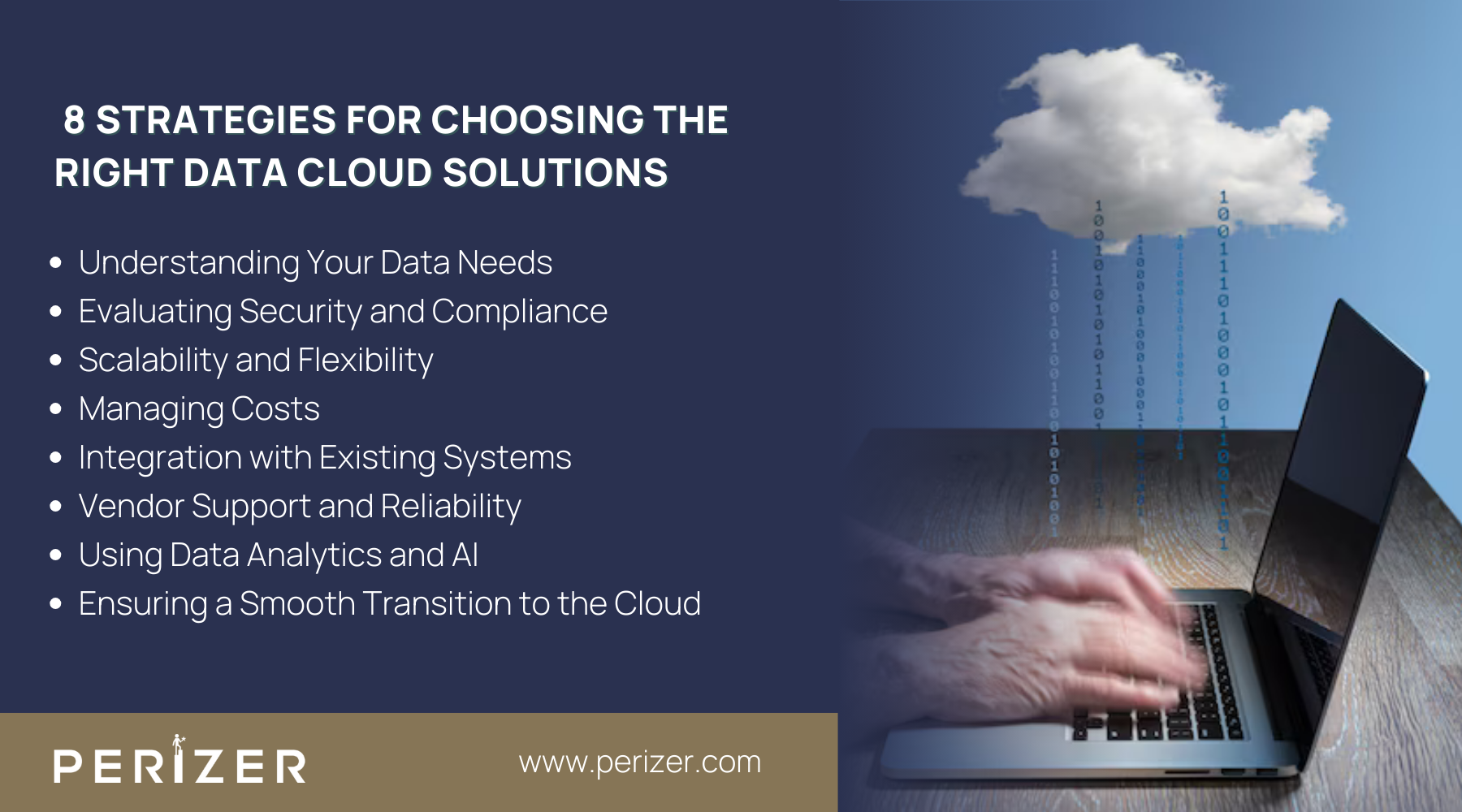Data Solutions
8 Essential Strategies for Selecting the Right Cloud Data Solution
Discover advanced strategies for selecting the right cloud data solution that ensures scalability, security, and seamless integration for your organization.

Choosing the right cloud data solution involves selecting a service that efficiently manages your data while seamlessly integrating with your existing systems and supporting your organization’s growth. This decision is important, as it can significantly influence your organization’s future success. With so many options available, the process can seem unacceptable. However, by focusing on how these solutions align with your specific needs and growth strategies, you can make a well-informed choice that sets your organization up for sustained success.
In this guide, we’ll explore advanced essential strategies to help you find a cloud data solution that truly meets your organization’s goals.
8 Strategies for Choosing the Right Data Cloud Solutions

1. Understanding Your Data Needs
Before you go into cloud solutions, it’s important to have a deep understanding of your organization’s data needs. This is more than just knowing what types of data you handle; it’s about comprehensively understanding how data flows through your organization, how it is used, and how it impacts your daily operations.
How to Assess Your Data Needs?
You can start by analyzing the types of data your organization processes. Are you primarily dealing with structured data like databases and spreadsheets, or do you also manage unstructured data, such as emails, documents, and images? Understanding the variety, volume, and velocity of your data is essential for selecting a cloud solution that can handle your processing needs. For example, if your organization handles high-velocity data, you’ll need a solution that supports real-time processing to ensure efficiency.
Additionally, think about the lifecycle of your data. How long do you need to retain data? What are your compliance requirements? Some industries demand strict data retention policies, and your cloud solution should be able to support these needs.
Opting for solutions that offer tiered storage can be particularly beneficial allowing you to store frequently accessed data in faster, more expensive storage while archiving older data in more cost-effective, slower storage. This approach ensures that your data is stored both efficiently and economically over time.
2. Evaluating Security and Compliance
When it comes to cloud data solutions, security should be at the forefront of your decision-making process. However, finding a provider that meets your current security needs and aligns with future regulatory and compliance requirements can be challenging.
How to Ensure Security and Compliance?
Start by carefully examining the security protocols of each potential cloud provider. Encryption is essential, but you should also look into how it is managed and what protections are in place for data at rest, in transit, and in use. Ensure the provider offers end-to-end encryption and allows you to control encryption keys. Also, verify that their security measures are regularly updated to meet the latest standards, keeping your data protected from evolving threats.
Next, check the provider's compliance certifications. Compliance with standards like GDPR, HIPAA, or SOC 2 may be mandatory depending on your industry. The cloud provider should offer tools to help you maintain compliance, such as data residency options and detailed audit trails, which not only meet regulatory requirements but also protect your organization from legal risks.
Finally, consider how the provider handles security incidents. Look into their response strategies for breaches or threats. A strong, transparent incident response plan is crucial for minimizing damage and ensuring smooth operations. Understanding their track record with security incidents can give you confidence in their ability to protect your data.
3. Scalability and Flexibility
As your organization grows, your cloud data solution must grow with you. Scalability and flexibility are key to ensuring that your solution adapts to changing needs without causing disruptions or incurring unnecessary costs.
How to Choose a Scalable and Flexible Solution?
When choosing a scalable and flexible cloud solution, start by considering your organization's growth. If your data volume is likely to increase quickly, you’ll need a cloud provider that can scale effortlessly. Look for auto-scaling features that adjust resources in real-time based on demand. This ensures you maintain high performance during peak times while only paying for the resources you use, helping to manage costs effectively.
Your cloud solution should easily integrate new data sources and adapt to changes in your business. Optimize for modular solutions that let you add or remove services without a complete reach. This flexibility ensures your cloud infrastructure stays aligned with your evolving needs as your organization grows and adjusts to new technologies.
If your organization operates in multiple regions, having a global reach is important. Choose a cloud provider with a global network of data centers to deliver low-latency services to customers, no matter their location. This also helps you comply with local data regulations, which becomes more important as your organization expands internationally. A provider with a global footprint ensures your services stay reliable and compliant, wherever you operate.
4. Managing Costs
While cloud solutions offer the potential for cost savings, expenses can quickly add up if not managed carefully. Therefore, it’s important to understand not just the upfront costs but also how expenses will evolve as your organization grows.
How to Manage Costs Effectively?
When choosing a cloud service provider, begin by understanding their pricing. Many providers use a pay-as-you-go model, which can be affordable but risky if your usage suddenly increases. To manage costs effectively, look for providers that offer tools like spending alerts and usage reports.
It's also important to explore long-term pricing options. Providers often offer discounts for reserved instances or long-term commitments. If you can predict your future usage, these options can lead to significant savings.
Resource optimization is important as well. Regularly review your cloud usage to eliminate waste, such as unused instances or oversized resources. Features like auto-scaling can help you use resources more efficiently, keeping your costs down.
Consider using multiple cloud providers. This approach can help you avoid depending on a single provider, optimize costs, and benefit from the best features each offers. Additionally, it adds redundancy, improving both performance and reliability.
5. Integration with Existing Systems
One of the biggest challenges in adopting a new cloud data solution is ensuring that it integrates smoothly with your existing systems. Poor integration can lead to inefficiencies and even create data silos, which undermine the benefits of moving to the cloud.
How to Ensure Seamless Integration?
Start by mapping out your current IT environment. Identify all the systems and applications that will need to interact with the cloud solution, including databases, CRM systems, and analytics tools. Understanding these interactions is important for selecting a solution that integrates smoothly without requiring extensive re-engineering. A well-planned integration strategy will minimize disruptions and ensure a smooth transition.
Next, evaluate the compatibility of the cloud solution with your existing infrastructure. Does the provider offer APIs that make integration easier, or will you need to develop custom connectors? The more natively the solution can integrate with your existing tools, the less disruption you’ll face during the migration. Ensuring compatibility can reduce the time and cost associated with migration and ongoing operations.
Data migration is another important consideration. Moving large volumes of data to the cloud can be complex, so choose a provider that offers strong migration support, including data transfer services, migration guides, and expert help to manage the process smoothly. A well-supported migration process reduces the risk of data loss and ensures that your systems remain operational during the transition.
Finally, plan for ongoing maintenance. Integration doesn't stop once the migration is complete; you'll need to ensure that updates to your cloud solution don’t disrupt your existing systems. Choose a provider that offers powerful support and tools to manage integrations over time. Continuous support ensures that your cloud environment remains stable and performs optimally, even as your needs evolve.
6. Vendor Support and Reliability
When choosing a cloud data solution, reliability and support are important. Downtime or poor support can lead to significant business disruptions, so it’s essential to select a vendor with a strong track record.
How to Choose a Reliable Vendor?
Start by examining the Service Level Agreements (SLAs) offered by each provider. A strong SLA should guarantee high uptime—usually 99.9% or higher—but it's also important to look at the provider's history. Research how often they've experienced outages and how quickly those issues were resolved. A provider with a strong SLA and a solid track record offers greater peace of mind, knowing that your data and applications will be available when you need them.
Support is just as important as reliability. Choose a vendor that offers 24/7 support through multiple channels, such as phone, email, and live chat. Consider the quality of that support - does the provider have industry-specific expertise? Are their support teams equipped to handle complex technical issues? High-quality, responsive support can be the difference between a minor issue and a major disruption.
Also, evaluate the provider’s incident management process. How do they communicate during outages or service disruptions? Do they provide timely updates and detailed post-incident reports? A transparent and proactive approach to incident management is essential for maintaining trust and minimizing downtime. Knowing that your provider has a strong incident management process in place can help you respond effectively to any issues that arise.
Lastly, consider the provider’s ecosystem. A strong network of partners and third-party tools can improve the reliability and support of your cloud solution, offering additional layers of service and expertise. This ecosystem can provide you with a broader range of solutions and support options, ensuring that your cloud environment meets your organization’s needs.
7. Using Data Analytics and AI
Key Steps to Use Data Analytics and AI in Cloud SolutionsSimply storing data isn’t enough, but to truly benefit from your data, you need to extract actionable insights that can drive decisions and spark innovation. This is where advanced analytics and AI can be of great help, turning raw data into valuable information that guides your strategy and operations
How to Use Data Analytics and AI?
Start by identifying the specific analytics and AI capabilities your organization needs, such as real-time data processing, or machine learning. Choose a cloud solution that aligns with these goals, ensuring it supports the necessary tools and infrastructure.
Scalability is also important as your data grows, ensuring your cloud solution can handle more complex queries without sacrificing performance, allowing your analytics capabilities to grow with your business.
Ensure seamless integration with existing analytics platforms like Tableau or Power BI. This will help you maximize your current investments while taking full advantage of the cloud's flexibility.
Consider the availability of AI and machine learning services. If your organization needs custom solutions, make sure the cloud platform allows you to build, train, and deploy custom models at scale.
Lastly, have a skilled team in place to interpret data and turn insights into action. Invest in training and development to ensure your team can fully use the potential of data analytics and AI.
8. Ensuring a Smooth Transition to the Cloud
Moving to a cloud data solution is a big job that needs careful planning and execution. Without a clear plan, you might run into delays, unexpected costs, and operational problems.
How to Plan and Execute a Smooth Transition?
Start by developing a clear migration strategy, including a timeline, stakeholder involvement, and task breakdown. Classify critical systems for migration first, followed by less essential ones. Phasing the migration allows for better control and faster problem resolution.
Effective communication is more significant to keep all your stakeholders informed through regular updates and clear documentation to manage expectations and reduce resistance to change.
Invest in comprehensive training for your team on the new cloud tools and processes. This will help them quickly adapt and fully utilize the new system.
Finally, conduct thorough testing before fully transitioning to the cloud. Run pilot projects and extensive tests to identify and fix issues early, ensuring a smooth and successful migration.
Conclusion
Selecting the right cloud data solution is a strategic decision that can significantly impact your organization's future success. By understanding your data needs, ensuring security and compliance, and focusing on scalability and flexibility, you can choose a solution that aligns with your business goals and adapts as your organization grows. Managing costs effectively, ensuring seamless integration with existing systems, and securing reliable vendor support are important steps in optimizing your cloud environment.
A successful cloud transition requires careful planning, thorough testing, and comprehensive training for your team to ensure a smooth and efficient migration. By following these advanced strategies, you can build a powerful cloud infrastructure that not only meets your current needs but also supports your long-term growth and operational excellence.
Stay Tuned With Our Latest Insights

Staff Augmentation
Learn how to select the perfect IT outsourcing partner to promote your team’s capabilities, improve productivity, and drRead more...

Staff Augmentation
Find the perfect staff augmentation partner by aligning your goals, evaluating expertise, managing costs, and ensuring aRead more...

Cyber Security
We focus on understanding the needs, behaviors, and expectations of your users through extensive user research. This infRead more...
